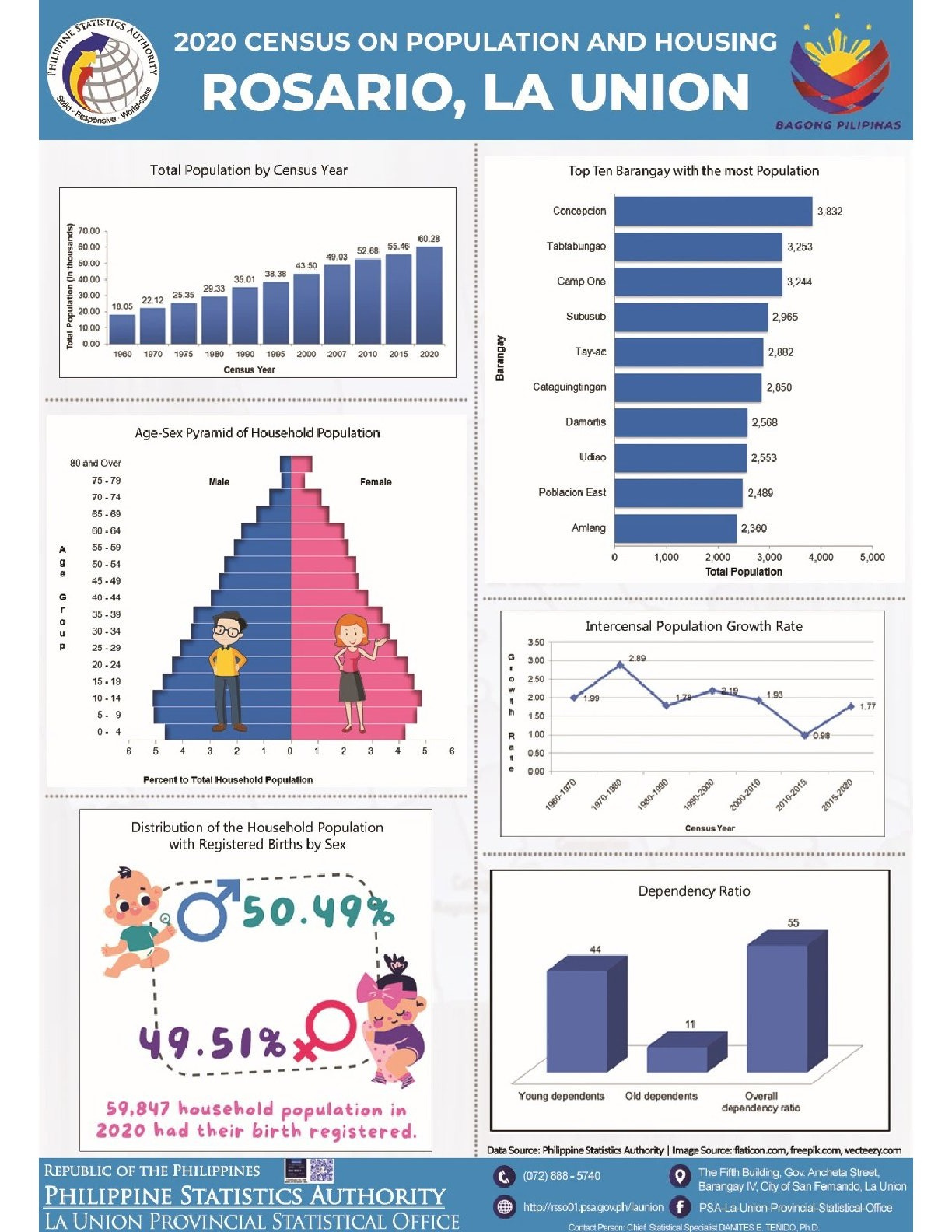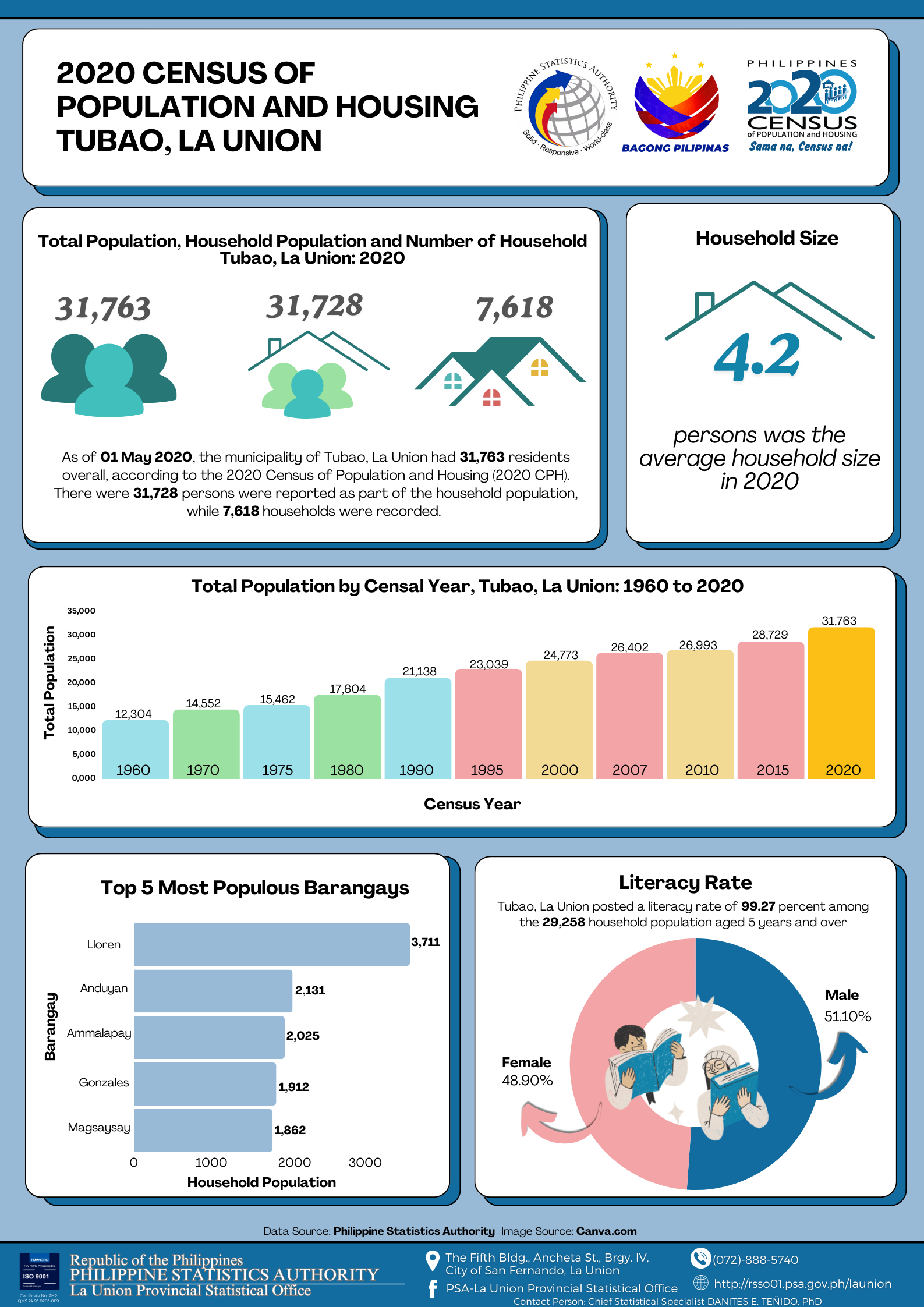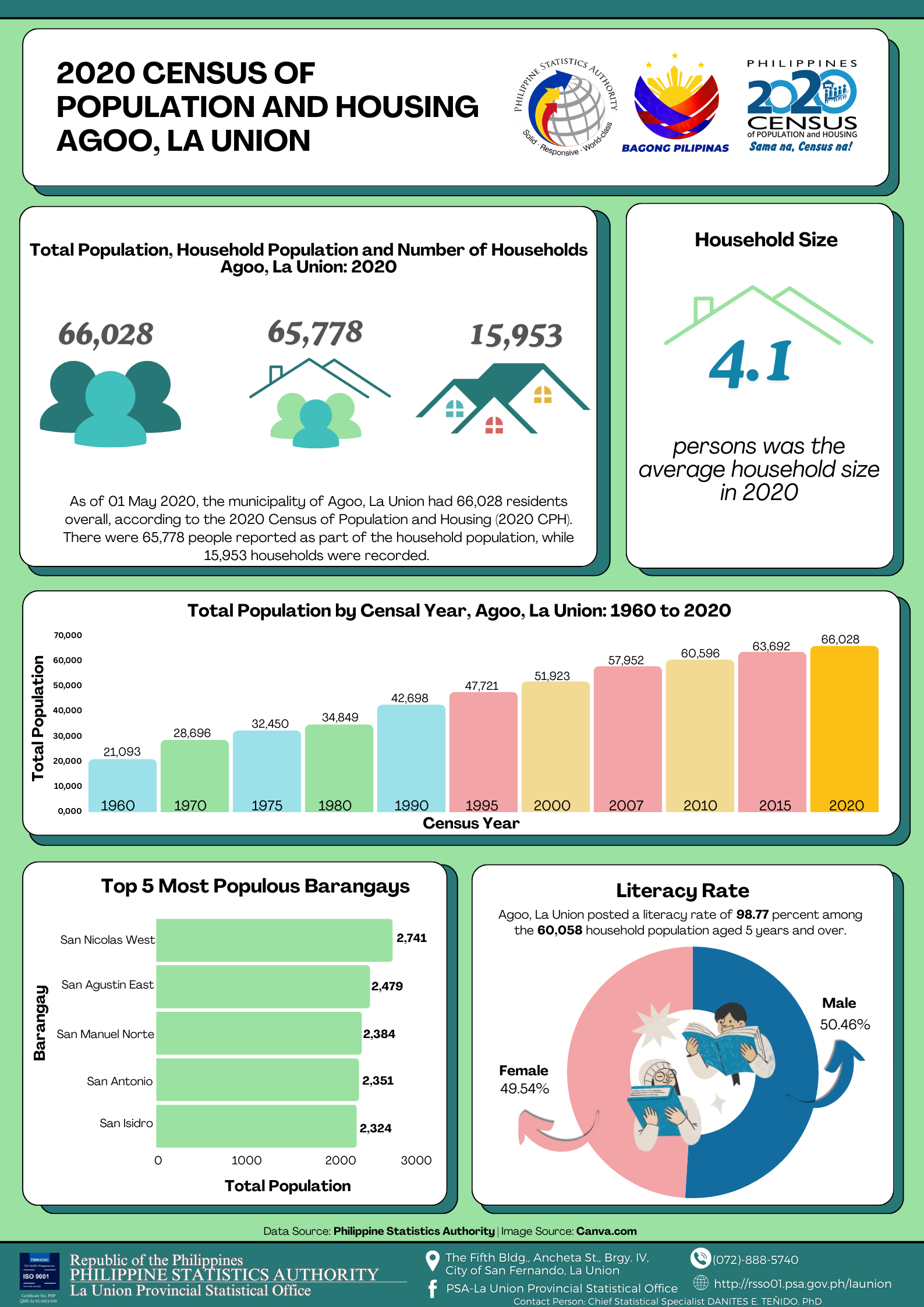Total population increases by 2.13 percent annually
Based on the 2020 Census of Population and Housing (2020 CPH), the municipality of Tubao, La Union posted a total population of 31,763 persons as of 01 May 2020. This translates to an increase of 3,034 persons over the total population of 28,729 persons in 2015 Census of Population (POPCEN). (Figure 1)
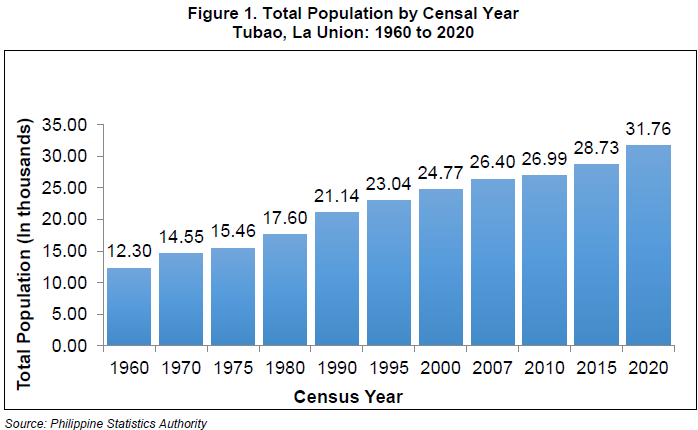
Population increases by 21 persons per year for every 1000 persons
The increase in the population count of the municipality of Tubao, La Union from 2015 to 2020 translated to an average annual population growth rate (PGR) of 2.13 percent. This means that there were about 21 persons added per year for every 1000 persons in the population. (Figure 2)
The annual PGR was lower at 1.19 percent during the period 2010 to 2015 and at 0.86 percent during the period 2000 to 2010.
If the average annual PGR recorded at 2.13 percent during the period 2015 to 2020 continues, the population of La Union would double in 33 years.
Sixty years ago, the population of Tubao, La Union was only 12,304 persons. This population size is more than one-third of the population of the municipality in 2020 CPH.
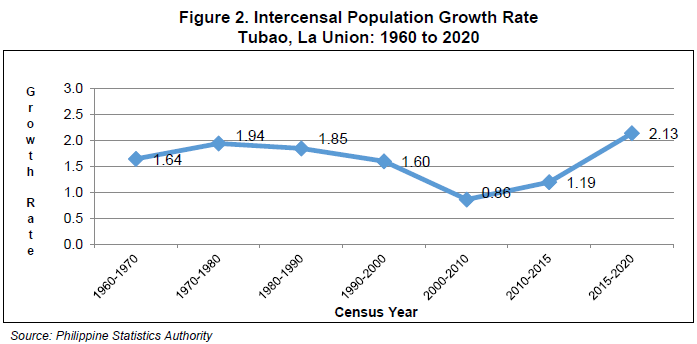
Barangay Lloren was the most populous in 2020
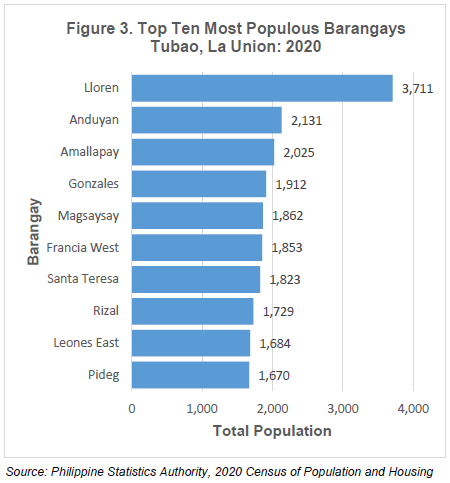
Among the 18 barangays of the Municipality of Tubao, La Union, Lloren was the most populous with a population size making up 11.68 percent of the total municipal population. Anduyan was second with 6.71 percent share, followed by Amallapay with 6.38 percent share, Gonzales with 6.02 percent share, Magsaysay with 5.86 percent share and Francia West with 5.83 percent share. The rest of the barangays contributed less than 5.80 percent each.
The least populated barangay was Poblacion with 2.61 percent share to the total population of the municipality. It was also the least populated barangay in 2015.
Sex ratio remains at 105 males per 100 females
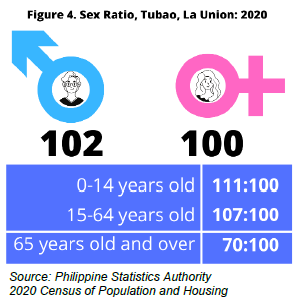
Of the 31,728 household population in 2020, males accounted for 51.15 percent while females comprised 48.85 percent. These figures resulted to a sex ratio of 105 males for every 100 females, a decrease in a sex ratio recorded in 2015. (Figure 4)
Males made up a higher percentage than females of those aged 0-64 years old. However, there were more females than males in the age group 65 years and over.
Median age increases to 28.28 years
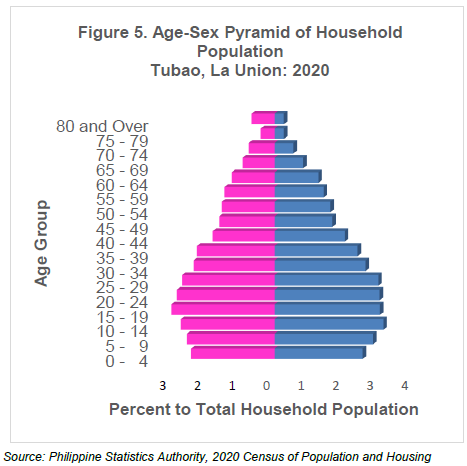
In 2020, the median age of the household population of the province was 28.28 years, which means that half of the population was younger than 28.28 years. This was higher than the median age of 26.55 years that was recorded in 2015.
Children aged 15 to 19 years (9.48%) comprised the largest age group, followed by those in the age groups 20 to 24 years (9.22%) and 10 to 14 years (9.21%). Males outnumbered females in the age group 0 to 54 years. On the other hand, there were more females than males in the older age group (55 years and over).
More than three fifths of the household population are of voting age
The voting-age population (18 years and over) accounted for 68.95 percent of the household population of the municipality in 2020, up from 65.35 percent in 2015. There were more males (50.62%) than females (49.38%) among the voting-age population.
Dependency ratio decreases to 48 dependents per 100 persons in the working age group
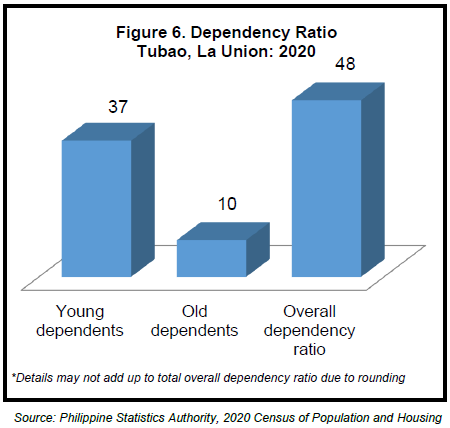
In 2020, the young dependents (0 to 14 years) comprised 25.46 percent of the household population while the old dependents (65 years and over) posted a share of 7.31 percent. The working age population (15 to 64 years) accounted for the remaining 67.23 percent.
The overall dependency ratio was 48, which indicates that for every 100 working age population, there were about 48 dependents (37 young dependents and 10 old dependents). This ratio is lower than the dependency ratio in 2015 recorded at 54 dependents per 100 working age population.
Males dominate females among the never-married persons
Of the household population 10 years old and over, 39.87 percent were married while 38.97 percent were never married. The rest of the population were categorized as follows: widowed (5.23%), common-law/live-in marital arrangement (14.76%), and divorced/separated (1.07%).
Among the never-married persons, 56.14 percent were males while 43.86 percent were females.
More females than males attain higher levels of education
Of the household population five years old and over, 25.30 percent had attended or completed elementary education while 44.79 percent had reached or finished high school. Moreover, 9.15 percent were college undergraduates and 14.71 percent were academic degree holders.
Among those with an academic degree, the females (57.73%) outnumbered the males (42.27%). Similarly, more females (67.01%) than males (32.99%) had pursued post baccalaureate courses.
Literacy rate was recorded at 99.27 percent
Tubao, La Union posted a literacy rate of 99.27 percent among the 29,258 household population aged 5 years and over. The literacy rate was higher among males (51.10%) than among females (48.90%).
Average household size is 4.2 persons
The household population of Tubao ,La Union in 2020 was 31,728 persons, higher by 2,999 persons from the household population of 28,729 persons in 2015.
The number of households in 2020 was recorded at 7,618 higher by 1,177 households compared with the 6,441 households posted in 2015. The average household size in 2020 was 4.2 persons, lower than the average household size of 4.5 persons in 2015.

Proportion of persons with registered births in Tubao, La Union is at 99.74 percent
The 2020 CPH revealed that a total of 31,647 persons had their births registered at the Local Civil Registry Office (LCRO). This is equivalent to 99.74 percent of the 31,728 household population in 2020.
More males than females have registered births
Among the 31,647 household population whose births were registered at the LCRO, 51.17 percent (16,195 persons) were males, while 48.83 percent (15,452 persons) were females. This translates to a sex ration of 104 males whose births were registered at the LCRO for every 100 females whose births were also registered. (Figure 8)
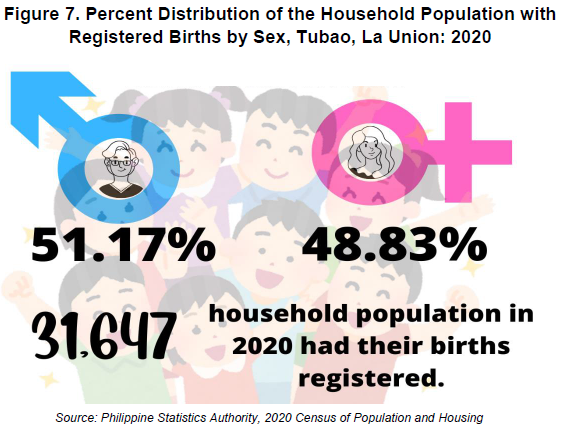
TECHNICAL NOTES
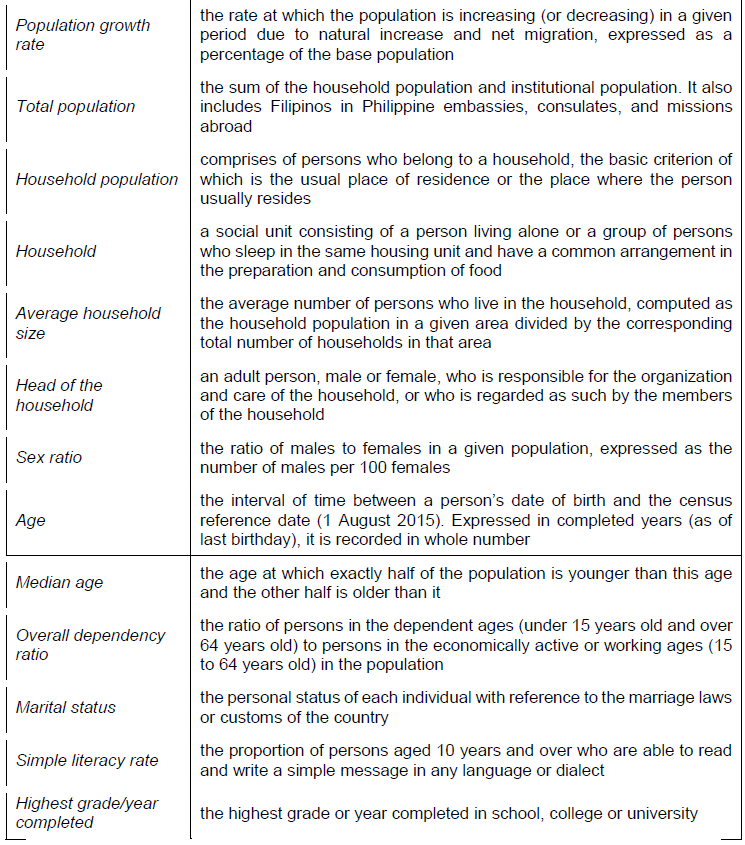
EXPLANATORY NOTES
The total population presented in this release is based on the 2020 CPH. The population count is declared official for all purposes by the President of the Philippines, pursuant to Proclamation No. 1179 dated 06 July 2021. The total population represents the total number of persons living as of 12:01 AM on 01 May 2020 in the country. It also includes Filipinos in Philippine embassies, consulates, and missions abroad.
SGD. DANITES E. TEÑIDO, PhD
Chief Statistical Specialist
KJGH/JNL


